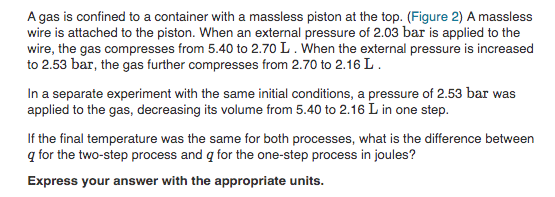A gas is confined to a container with a massless piston at the top. (Figure 2) A massless wire is attached to the piston. When an external pressure of 2.03 bar is applied to the wire, the gas compresses from 5.40 to 2.70 L . When the external pressure is increased to 2.53 bar, the gas further compresses from 2.70 to 2.16 L. In a separate experiment with the same initial conditions, a pressure of 2.53 bar was applied to the gas, decreasing its volume from 5.40 to 2.16 L in one step. If the final temperature was the same for both processes, what is the difference betweer q for the two-step process and q for the one-step process in joules? Express vour answer with the appropriate units.
A gas is confined to a container with a massless piston at the top. (Figure 2) A massless wire is attached to the piston. When an external pressure of 2.03 bar is applied to the wire, the gas compresses from 5.40 to 2.70 L . When the external pressure is increased to 2.53 bar, the gas further compresses from 2.70 to 2.16 L. In a separate experiment with the same initial conditions, a pressure of 2.53 bar was applied to the gas, decreasing its volume from 5.40 to 2.16 L in one step. If the final temperature was the same for both processes, what is the difference betweer q for the two-step process and q for the one-step process in joules? Express vour answer with the appropriate units.
Introductory Chemistry: An Active Learning Approach
6th Edition
ISBN:9781305079250
Author:Mark S. Cracolice, Ed Peters
Publisher:Mark S. Cracolice, Ed Peters
Chapter4: Introduction To Gases
Section: Chapter Questions
Problem 67E: The compression ratio in an automobile engine is the ratio of the gas pressure at the end of the...
Related questions
Question

Transcribed Image Text:A gas is confined to a container with a massless piston at the top. (Figure 2) A massless
wire is attached to the piston. When an external pressure of 2.03 bar is applied to the
wire, the gas compresses from 5.40 to 2.70 L. When the external pressure is increased
to 2.53 bar, the gas further compresses from 2.70 to 2.16 L.
In a separate experiment with the same initial conditions, a pressure of 2.53 bar was
applied to the gas, decreasing its volume from 5.40 to 2.16 L in one step.
If the final temperature was the same for both processes, what is the difference between
q for the two-step process and q for the one-step process in joules?
Express your answer with the appropriate units.
Expert Solution
This question has been solved!
Explore an expertly crafted, step-by-step solution for a thorough understanding of key concepts.
This is a popular solution!
Trending now
This is a popular solution!
Step by step
Solved in 3 steps

Knowledge Booster
Learn more about
Need a deep-dive on the concept behind this application? Look no further. Learn more about this topic, chemistry and related others by exploring similar questions and additional content below.Recommended textbooks for you

Introductory Chemistry: An Active Learning Approa…
Chemistry
ISBN:
9781305079250
Author:
Mark S. Cracolice, Ed Peters
Publisher:
Cengage Learning

Principles of Modern Chemistry
Chemistry
ISBN:
9781305079113
Author:
David W. Oxtoby, H. Pat Gillis, Laurie J. Butler
Publisher:
Cengage Learning

Physical Chemistry
Chemistry
ISBN:
9781133958437
Author:
Ball, David W. (david Warren), BAER, Tomas
Publisher:
Wadsworth Cengage Learning,

Introductory Chemistry: An Active Learning Approa…
Chemistry
ISBN:
9781305079250
Author:
Mark S. Cracolice, Ed Peters
Publisher:
Cengage Learning

Principles of Modern Chemistry
Chemistry
ISBN:
9781305079113
Author:
David W. Oxtoby, H. Pat Gillis, Laurie J. Butler
Publisher:
Cengage Learning

Physical Chemistry
Chemistry
ISBN:
9781133958437
Author:
Ball, David W. (david Warren), BAER, Tomas
Publisher:
Wadsworth Cengage Learning,

General Chemistry - Standalone book (MindTap Cour…
Chemistry
ISBN:
9781305580343
Author:
Steven D. Gammon, Ebbing, Darrell Ebbing, Steven D., Darrell; Gammon, Darrell Ebbing; Steven D. Gammon, Darrell D.; Gammon, Ebbing; Steven D. Gammon; Darrell
Publisher:
Cengage Learning

Chemistry for Engineering Students
Chemistry
ISBN:
9781337398909
Author:
Lawrence S. Brown, Tom Holme
Publisher:
Cengage Learning

Chemistry by OpenStax (2015-05-04)
Chemistry
ISBN:
9781938168390
Author:
Klaus Theopold, Richard H Langley, Paul Flowers, William R. Robinson, Mark Blaser
Publisher:
OpenStax